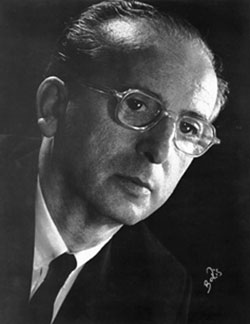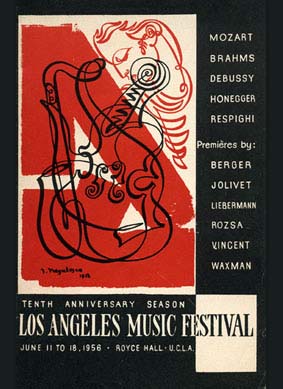

BIOGRAPHY
Franz Waxman led a variety of musical lives as composer, conductor and impresario. He was born in Konigshutte, Upper Silesia, Germany, on December 24, 1906, and was the youngest of six children. No one in the family was musical except Franz, who started piano lessons at the age of seven. His father was an industrialist, and not believing his son could earn a living in music, encouraged him in a banking career. He worked for two and a half years as a teller and used his salary to pay for lessons in piano, harmony and composition. He then quit the bank and moved to Dresden and then to Berlin to study music.
During this period he paid for his musical education by playing piano in nightclubs and with the Weintraub Syncopaters, a popular jazz band of the late 1920s. While with the band he began to do their arrangements, and this led to orchestrating some early German musical films. Frederick Hollander, who had written some music for the Weintraubs, gave Waxman his first important movie assignment: orchestrating and conducting Hollander’s score for Josef von Sternberg’s classic film, “The Blue Angel.” The film’s producer, Erich Pommer, who was also head of the UFA Studios in Berlin, was so pleased with the orchestration of the score that he gave Waxman his first major composing assignment: Fritz Lang’s version of “Liliom” (1933) which was filmed in Paris after their exodus from Germany. Pommer’s next assignment, Jerome Kern’s “Music in the Air” (Fox Films, 1934), took him to the United States, and he brought Waxman with him to arrange the music.
Waxman’s first original Hollywood score was James Whale’s “The Bride of Frankenstein” (1935), which led to a two-year contract with Universal as head of the music department. He scored a dozen of the more than 50 Universal films on which he worked as music director. Among the best known are “Magnificent Obsession, “Diamond Jim” and “The Invisible Ray.”
Two years after he went to Hollywood, Waxman, then 30, signed a seven-year contract with Metro-Goldwyn-Mayer to compose. He averaged about seven pictures a year, and it was during this period that he scored such famous Spencer Tracy films as “Captains Courageous,” “Dr. Jekyll and Mr. Hyde” and “Woman of the Year.” In 1937, he was loaned by M-G-M to David O. Selznick for “The Young at Heart” and was nominated for both Best Original Music and Best Score – the first two of 12 Academy Award nominations he was to receive for the 144 films he scored in his 32 years in Hollywood. In 1940 he was again loaned to Selznick, this time for “Rebecca,” and was nominated for his third Academy Award.
Waxman left M-G-M in 1943 and began a long association with Warner Brothers. “Old Acquaintance” is from this period. (Selections from three more of his Warner Brothers scores can be heard on RCA albums: “Mr. Skeffington” is included in “Classic Film Scores for Bette Davis,” “To Have and Have Not,” and “The Two Mrs. Carrolls” are included in “Casablanca – Classic Film Scores for Humphrey Bogart, and “Objective, Burma!” are on “Captive Blood” – Classic Film Scores for Errol Flynn)
In 1947 Waxman founded the Los Angeles International Music Festival, which he was to head for 20 years. World and American premieres of 80 major works by composers such as Stravinsky, Walton, Vaughan Williams, Shostakovitch and Schoenberg were given at the festival.
By 1947 Waxman had a busy schedule indeed. In addition to devoting a great deal of time to the festival, he was in demand at all the major studios, was guest conducting symphony orchestras in Europe as well as in the United States and was composing concert music. For the film “Humoresque” he wrote a special piece based on themes from Bizet’s “Carmen,” which was played by Isaac Stern on the soundtrack. The “Carmen Fantasie” has become standard repertoire and was recorded by Jascha Heifetz for RCA. Among Waxman’s other concert works are “Overture for Trumpet and Orchestra,” based on themes from “The Horn Blows at Midnight;” “Sinfonietta for String Orchestra and Timpani;” a dramatic song cycle “The Song of Terezin,” and an oratorio, “Joshua.”
Waxman won the Academy Award in 1950 for Billy Wilder’s “Sunset Boulevard” and in 1951 for George Stevens’ “A Place in the Sun.” For over half a century, he was the only composer to have won the award for Best Score in two successive years. It was during the ‘50s and ‘60s that he composed some of his most important and varied scores. These are represented by the above two Academy Award winners as well as by “Prince Valiant” and “Taras Bulba.” He had usually been associated with romantic films, but now he progressed to epic and jazz-oriented scores. “Crime in the Streets,” “The Spirit of St. Louis,” “Sayonara,” “Peyton Place” and “The Nun’s Story” are also from this period and the complete scores were issued on soundtrack albums. Franz Waxman received many honors during his lifetime, including the Cross of Merit from the Federal Republic of West Germany, honorary memberships in the Mahler Society and the International Society of Arts and Letters, and an honorary doctorate of letters and humanities from Columbia College. He died February 24, 1967, in Los Angeles at the age of 60.
Together with Erich Wolfgang Korngold, Max Steiner, Dimitri Tiomkin, Bernard Herrmann and Alfred Newman a United States postage stamp was issued in 1999. During the recent Waxman centenary a street in his birthplace was named Franz Waxmanstrasse. The Academy of Motion Picture Arts & Sciences and Turner Classic Movies held tributes. The Museum of Modern Art in New York presented a 24 picture retrospective; this was the first time that MoMA honored a composer. The Chicago Symphony Orchestra recently performed the complete score THE BRIDE OF FRANKENSTEIN live to film.


LOS ANGELES MUSIC FESTIVAL
In May 1947, Franx Waxman organized, directed, and underwrote a series of concerts with the name “Beverly Hills Music Festival.” By 1949, this venture was renamed the Los Angeles Music Festival and that year’s concerts were billed as the “third annual season.” Officially, the Festival’s programs were sponsored by The Los Angeles Orchestral Society, which Waxman established specifically to sponsor the concerts. Throughout the twenty-year history of the Festival, the musicians were drawn mainly from the local professional community.
The Festival, sandwiched between the Philharmonic’s fall-spring season and the summer programs of the Hollywood Bowl, showed from the start the stamp of Waxman’s interests and aesthetic goals. Waxman was one of the pioneers of the “mixed” program that shed new light on familiar masterworks by setting them in the context of contemporary compositions. Reviewing the concert of June 2, 1954, Los Angeles Daily News critic Mildred Norton wrote that the new season “continued the tradition now established by the festival’s founder-director Franx Waxman® of offering unhackneyed and stimulating departures from the usual.” Although he was part of the film industry, which is often (and wrongly) associated with conservative musical attitudes, Waxman was a strong champion of contemporary music, as the concert programs clearly reveal. Even Mozart is outpaced by LA resident Stravinsky. Arthur Honegger, for whom Waxman felt a particular affinity, is well represented, and among the most striking events of the Festival’s history were the world premiere of Stravinsky’s Agon in 1957 and the West Coast premiere of Britten’s War Requiem, under Waxman’s direction, that took place within two years of the work’s publication in 1962.
Beginning with the 1956 season CBS Radio selected concert performances from the Los Angeles Music Festival for broadcast throughout the United States and overseas as part of their World Music Festivals. The Los Angeles Music Festival was included among programs in Bergen (Norway), Helsinki (Finland), and Salzburg (Austria).
Reviews of Festival concerts — like those in other venues — routinely praise Waxman’s skill as a conductor: his clarity of gesture, richness of expression, evidence of meticulous preparation, communication with the players, and shaping of the whole.
As early as its second year, the Festival concerts were mostly held on the UCLA campus, and gradually a close connection was established to the School of Music. The 1961 festival was named the “First International Los Angeles Music Festival,” and on June 6 UCLA’s Schoenberg Hall was the site for an “International Composers Conference” with a panel moderated by Roy Harris and including Karl-Birger Blomdahl, Werner Egk, Lukas Foss, Blas Galindo, Iain Hamilton, Kara Karayev, Tikhon Khrennikov, Milhaud, Piston, Rozsa, Stravinsky, John Vincent, Elinor Remick Warren, and Waxman himself. Two days later, an “International Critics’ Symposium” was moderated by the Dean of USC’s School of Music, Raymond Kendall.
The 1962 festival, which listed Waxman as “founder and music director,” was also an “international festival” designed like the previous year: four concerts with a “Symposium on the Arts” tucked in the middle. By 1963, the official name of the festival became the “Los Angeles International Music Festival, “ but a year later the name reverted to “Los Angeles Music Festival” and changed format to include two concerts and two recitals. The 1965 season included a cycle of all the Beethoven piano concertos played by Rudolf Serkin, and the final season (1966) returned to a format used twice earlier: three orchestral concerts and another of concert jazz compositions. It is both touching and appropriate that the last composition performed in the Festival series was Waxman’s own orchestral song cycle, The Song of Terezin.
The tables provide details of the programs for all concerts in the Festival series, from 1947 to 1966. The first table is chronological, the second provides the same information but is sorted by composer name.
ADDITIONAL RESOURCES
PAPERS AT SYRACUSE
Housed in the Special Collections Research Center at the Syracuse University Library, the Franz Waxman Papers comprises correspondence, writings, memorabilia, and scores. Click here to be taken to Syracuse website, a detailed list of its contents, and information about visiting the collection.
♦
SCORE LIBRARY
Waxman had a vast collection of scores of various classical composers that are housed with the rest of his papers. Click here to read a detailed list of his personal library.
♦
EXILES IN HOLLYWOOD
At the MOLA conference in Los Angeles in 2005, John Mauceri gave a presentation focusing on the émigré composers who fled an increasingly hostile Europe for Hollywood prior to and during the Second World War. Click here to read an edited version of the original talk which explains the historical context of the LAMF.
♦
FILMOGRAPHY
Waxman composed the scores for over 150 movies in his lifetime. Click here for a link to Internet Movie Database and a list of Waxman’s full filmography.
♦
BIBLIOGRAPHY
Segal, Rachel: ‘FRANZ WAXMAN: The Composer As Auteur in Golden Era Hollywood’ (PhD thesis Newcastle University, UK)
Cieslinski, Marek, Kosma: Franz Waxman: The Winner of Oscars from Konigshutte, Chorzow 2006, Poland, www.medial.media.pl, ISBN 83-60360-05-7